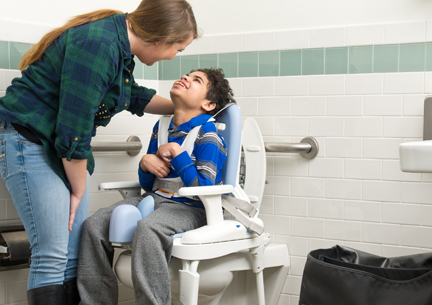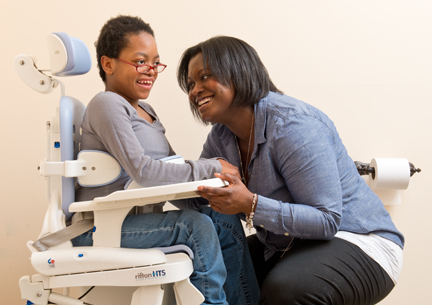Toileting Initiative Produces Great Results
Staying Clean and Dry at Battle Monument School
| March 2017 It all started when therapists from the three special day schools of Baltimore County Public Schools sat down to talk at one of our yearly meetings. The discussion turned from the mundane to the visionary, how to provide more functional, purposeful activities for our kiddos throughout the day. And, of all things, we talked about toileting. As a vital part of the student’s day, we wanted the toileting process to include the teaching of motor, functional and communication skills.
It all started when therapists from the three special day schools of Baltimore County Public Schools sat down to talk at one of our yearly meetings. The discussion turned from the mundane to the visionary, how to provide more functional, purposeful activities for our kiddos throughout the day. And, of all things, we talked about toileting. As a vital part of the student’s day, we wanted the toileting process to include the teaching of motor, functional and communication skills.
And so our toileting initiative was born. (Who else but school therapists can get as excited as this over toileting skills!) With such potential to maximize and foster functional independence in the students, our initiative won the approval of our administrators. We implemented it.
 How it Works
How it Works
Nineteen students ranging from ages 3 to 21 participate in the toileting initiative, performing sit-to-stand transitions for standing clothing management (with the assistance of staff or the Support Station as needed), then sitting on an adaptive toilet for 3-5 minutes with the appropriate supports and prompts. Within just a month we had 200 successful voids on the toilet (yes, we counted them!). This was huge. Within 3 months, 600 successful voids—that equals 600 less soiled diapers which means we’re saving money too.
 Many childhood experts talk about the signs of toileting “readiness,” but here at Battle Monument we’ve shown that those signs are not always necessary. Some students with special needs we never thought could toilet (definitely not showing the typical signs of readiness) successfully void in the toilet when they are given an opportunity to try. We celebrate these moments every time. It’s life-changing for the student especially when they transfer out of the school system. Adult agencies often do not have time or staffing when it comes to assisting in hygiene care and will turn applicants away who require more supervision in that area. So the more we foster independence and responsibility in hygiene care, the better the prospects for our students in the future.
Many childhood experts talk about the signs of toileting “readiness,” but here at Battle Monument we’ve shown that those signs are not always necessary. Some students with special needs we never thought could toilet (definitely not showing the typical signs of readiness) successfully void in the toilet when they are given an opportunity to try. We celebrate these moments every time. It’s life-changing for the student especially when they transfer out of the school system. Adult agencies often do not have time or staffing when it comes to assisting in hygiene care and will turn applicants away who require more supervision in that area. So the more we foster independence and responsibility in hygiene care, the better the prospects for our students in the future.
After sitting on the adaptive toilet, the students then transfer back to standing position for clothing adjustment. Here again we are looking at giving the student a chance to practice a sit-to-stand transfer, weight-bear (great for hip formation and bone health) and perform self-care in a functional position. Best of all, this process is so much more dignified for the student than lying on a changing table.
 Building Communication
Building Communication
Toileting is also an excellent opportunity to build communication skills, and we now see our students initiating requests to use the toilet. In the bathroom we have voice-output devices where a student can indicate “more” for more time on the commode or that they are “finished.” Additionally, our SLP worked hard to make visual sequences inside the stall doors to identify the steps in the toileting to make transitions easier.
Organization is Key
Providing opportunities for our students to be toileted (about four times a day) takes organization. First we evaluate each student and determine individual toileting goals and the special needs toilet equipment needed.
We have a chart indicating when each student is scheduled to use the restroom and the staff assisting them. Students go in groups of four accompanied by two or three staff and work through the transfer-commode-transfer rotation. For example, while the first student is sitting on the commode, another stands at the Support Station. Once the second student is finished with clothing management and sitting on the commode, the first student is ready to transfer off the commode for clothing management and return to class. There is no down-time in the bathroom and the time away from class is minimal.
Lovingly dubbed the “bathroom ninja” an administration-identified additional adult assistant takes the helm on the toileting initiative. He helps expedite the toileting process when classes are running late. He’s the one in charge of data collection on successful voids, making sure the equipment is always clean and assisting with training new staff members. He’s indispensable!
 We Believe It Can Be Different
We Believe It Can Be Different
We’ve heard stories that make what we do even more important. One parent told me they changed their teenage child on the floor in a public restroom because no changing tables were big enough. Another avoids going out in the community just in case their child may need a diaper change. So we’re doing this to help students and their caregivers not just at school but at home and in the community. If we can make the toileting process easier while in public or give them a time-frame that their child is typically dry, it will make community outings much less stressful and a lot more fun. Because we believed it can be different we’re seeing our kids defy expectations. It’s amazing what they accomplish when given time and someone patient enough to wait on the success.




